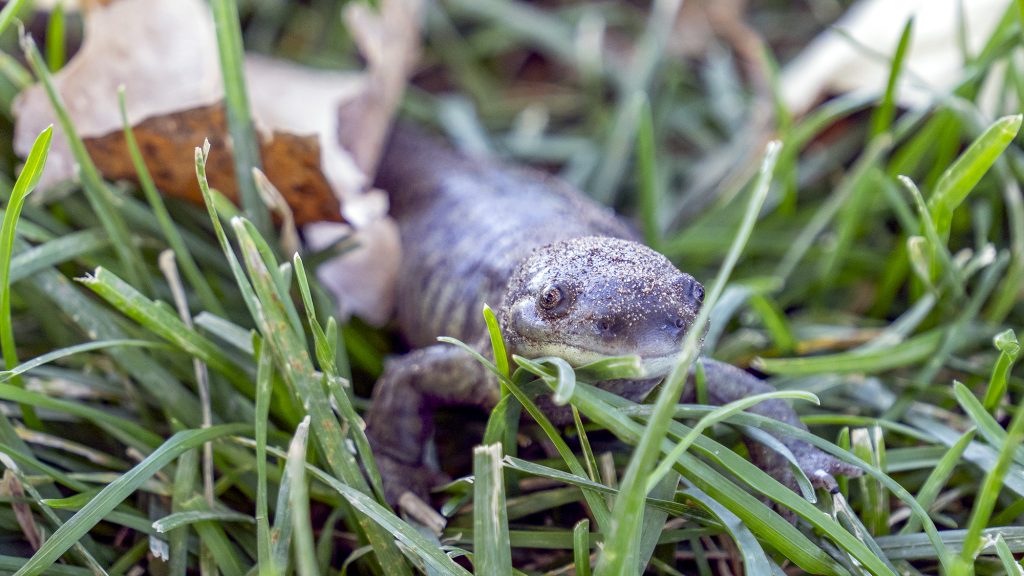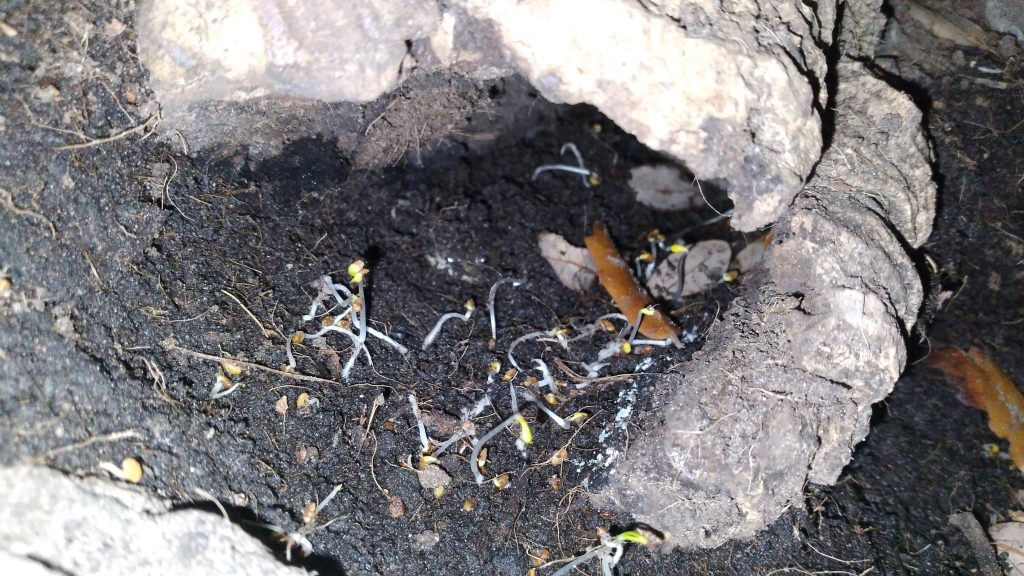ST. GEORGE — As temperatures fall and ponds dry, Utah’s only native salamander digs into muddy earth or lakebeds to keep warm this winter. Some remain active but slow under icy waters.

How does this amphibian survive Southern Utah’s harsh environments?
Barred tiger salamanders, Ambystoma mavortium, are a type of mole salamander that spends the majority of its life underground, which is one reason many Southern Utahns are unaware of their existence, said Dr. Bill Heyborne, a biology professor at Southern Utah University.
Also called Western tiger salamanders, they are one of the largest terrestrial salamanders in the world, “which is kind of cool,” he told St. George News.
“They might spend months or even years in some instances just completely buried underground, waiting for the right environmental conditions to come out,” he said. “And so if we get a good rain or have a good monsoon season, then a lot of them will emerge from their underground burrows and will come out looking for places to feed and reproduce.”

While the amphibians have lungs and can move freely through moist habitats, they require water to reproduce, Heyborne said. They typically lay eggs in lakes, ponds or seasonal pools.
“They hatch out into these little aquatic larvae that have gills,” he said. “And so the larvae have to be in water until they undergo metamorphosis, kind of like tadpoles.”
Larval tiger salamanders are similar in appearance to axolotls, and the two species are closely related. Axolotls remain aquatic their entire lives, Heyborne said.
Tiger salamanders can live for over a decade, Heyborne said. The time it takes juveniles to mature is highly variable, ranging from a few months to several years, depending on food abundance and water temperature, among other factors.

Some may not metamorphose at all, becoming sexually mature in their larval stage, according to the Utah Division of Wildlife Resources. In the southwest, the species typically breeds in the late winter, spring and summer, when adults are most likely to be observed.
In the winter, adults bury themselves underground, below the frost line, to survive freezing temperatures.
Salamander larvae are most likely to be observed in the summer or fall before they’ve metamorphosed. Those who remain aquatic may burrow into muddy lake bottoms or remain active beneath the ice if their pond remains partially unfrozen, Heyborne said.

“But of course, it gets really cold, and so they slow way, way down,” he added. “So they may not even move for days or weeks at a time, waiting for the water to warm back up.”
Tiger salamanders are predatory and will feed on “basically anything that will fit in their mouth,” including insects and smaller salamanders — particularly while in their larval stage.
“Kind of gross, but you know, you got to get food where you can,” Heyborne said.
Adults are preyed on less frequently because they spend most of their lives underground. But thousands of larvae can live in a single, small pond, making them an easier meal for frogs and fish, among others. For this reason, the amphibians tend to be rare in areas inhabited by predatory fish, Heyborne said.

“The alpine ponds (at Cedar Breaks National Monument) for a long time were well-known as tiger salamander breeding locations,” he said. “So you could go there, and there were a ton of tiger salamanders, and then someone illegally introduced fish — they carried them in and turned them loose — and the fish wiped out all of the tiger salamanders.”
Since then, the park staff has removed the fish, allowing salamanders to return, Heyborne said. If hikers looked closely, they could see larvae swimming in Alpine Pond’s clear, reflective water.
Due to last year’s wet winter, Cedar City’s Quichapa Recreation Area was “loaded with tiger salamanders,” Heyborne said. And people have reported multiple sightings of adults during and after rainstorms.
Southern Utahns have historically found the species in cow ponds along the road to Zion National Park and throughout Washington County, said Ammon Teare, outreach coordinator at Red Cliffs Desert Reserve.
Supporting the species

While Western tiger salamanders are not federally protected, they are considered a controlled species in Utah, according to the DWR. So, people cannot remove them from the wild without taking an orientation course and obtaining a collection permit.
Because amphibians can absorb toxins through their skin, Heyborne said people should avoid handling them as they could be negatively affected by the chemicals in hand lotions, sunscreens and other products.
If found in a dangerous situation, individuals can pick them up and move them to a safer area in the direction they were traveling, he added.
While salamander population trends are difficult to track, partly because adults are elusive, Heyborne said there is a general concern for the species.

For instance, salamanders are susceptible to chytrid fungus and other diseases that contribute to amphibian population declines worldwide.
These declines “continued unabated” in the U.S. since the 1960s, at an average rate of 3.79% annually, according to the U.S. Geological Survey. The rate of decline is more severe on the West Coast and in the Rocky Mountains.
“If this rate remains unchanged, some species will disappear from half of the habitats they occupy in about 20 years,” the department’s staff wrote.
Because amphibians breathe partly through their skin, they are good indicators of environmental health and change. They are more sensitive to disease, pollution, toxins, ultraviolet radiation and habitat destruction, according to the survey.

“The worldwide occurrences of amphibian declines and deformities could be an early warning that some of our ecosystems, even seemingly pristine ones, are seriously out of balance,” the survey states.
To learn more about the species and see them in person as temperatures drop, Southern Utahns can visit the Red Cliffs Discovery Center at 111 East Tabernacle Street in St. George.
Or, they can attend an event featuring SUU’s Animal Ambassadors with the various animals they present, including tiger salamanders. Public events are often posted on the group’s Facebook page.
Additionally, those interested in scheduling an event or donating to the program can find Heyborne’s contact information here.
Photo Gallery
An axolotl swims in an aquarium in this stock image | Image courtesy of LaDameBucolique/Pixabay, St. George News A tiger salamander swims in a cold pond in the Tushar Mountains, Utah, Sept. 22, 2023 | Photo by Alysha Lundgren, St. George News A barred tiger salamander crawls through dirt, Cedar City, Utah, Oct. 17, 2023 | Photo by Alysha Lundgren, St. George news A barred tiger salamander crawls through grass, Cedar City, Utah, Oct. 17, 2023 | Photo by Alysha Lundgren, St. George news A barred tiger salamander rests on its water dish at the Red Cliffs Discovery Center, St. George, Utah, April 11, 2023 | Photo by Alysha Lundgren, St. George News A barred tiger salamander crawls through grass, Cedar City, Utah, Oct. 17, 2023 | Photo by Alysha Lundgren, St. George news A tiger salamander crawls at the Red Cliffs Discovery Center, St. George, Utah, date unspecified | Photo courtesy of the Red Cliffs Desert Reserve, St. George News Yoshi the salamander swims, Cedar City, Utah, date unspecified | Photo courtesy of Randal Vincent, St. George News A tiger salamander swims in a cold pond in the Tushar Mountains, Utah, Sept. 22, 2023 | Photo by Alysha Lundgren, St. George News Toad the Salamander burrows under dirt, Cedar City, Utah, date unspecified | Photo courtesy of Randal Vincent, St. George News A barred tiger salamander crawls through grass, Cedar City, Utah, Oct. 17, 2023 | Photo by Alysha Lundgren, St. George news A tiger salamander swims in a cold pond in the Tushar Mountains, Utah, Sept. 22, 2023 | Photo by Alysha Lundgren, St. George News A barred tiger salamander crawls through dirt, Cedar City, Utah, Oct. 17, 2023 | Photo by Alysha Lundgren, St. George news












Copyright St. George News, SaintGeorgeUtah.com LLC, 2023, all rights reserved.

